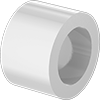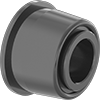Sleeve Bearings
5789 ProductsOil-Embedded Sleeve Bearings
Dry-Running Sleeve Bearings
Sleeve Bearings
Oil-Embedded Flanged Sleeve Bearings
Dry-Running Flanged Sleeve Bearings
Flanged Sleeve Bearings
Oil-Embedded Thrust Bearings
Dry-Running Thrust Bearings
Thrust Bearings
What is a Sleeve Bearing?
Sleeve bearings are a type of plain bearing that are widely used in various industrial applications. These bearings have a simple design, consisting of a cylindrical sleeve that encases a rotating shaft. Sleeve bearings are typically made from materials such as bronze, brass, or plastic. Sleeve bearings are commonly used in a wide range of industrial applications due to their simplicity, reliability, and cost-effectiveness.
Advantages of Sleeve Bearings
Sleeve bearings offer several advantages over other types of bearings, such as ball bearings or roller bearings. For one, they are more cost-effective, since they have a simpler design and require less material. Additionally, sleeve bearings are self-lubricating, which means they do not require frequent maintenance or lubrication.
What are Sleeve Bearings Used for?
Sleeve bearings are used in a wide range of industrial applications, including in motors, generators, pumps, and fans. They are also used in automotive engines, aerospace equipment, and construction machinery. Sleeve bearings are particularly well-suited for high-speed applications, where their self-lubricating properties help to reduce friction and wear.
Design Considerations for Sleeve Bearings
When selecting sleeve bearings you need to consider size, shape, contact angle, mounting configuration, radial design load and clearance values. Sleeved-type journal bearings offer low-friction operation and corrosion resistance while flanged-type bushings are better suited for highly loaded axial components. Incorrect setup can lead to premature wear-out or failure so it's important to choose the right clearance value.
How to Choose Sleeve Bearings?
When choosing sleeve bearings, it's important to consider factors such as load capacity, operating speed, and temperature range. Other factors to consider include the type of material used, as well as the dimensions and tolerances of the bearing. By choosing the right sleeve bearings for your application, you can ensure reliable and efficient operation of your equipment.
Conclusion
In conclusion, sleeve bearings are a cost-effective and reliable solution for many industrial applications. They offer several advantages over other types of bearings, including their simplicity, self-lubricating properties, and suitability for high-speed applications. By choosing the right sleeve bearings for your equipment, you can ensure optimal performance and longevity.




























































